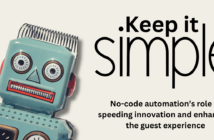Giving guests control over the room environment is a smart first step toward happier guests and better online reviews
by John Attala
“You can please some of the people all of the time, you can please all of the people some of the time, but you can’t please all the people all of the time.” Those words (spoken by John Lyndgate and made famous by Abraham Lincoln) were never truer than they are today in hospitality. Thankfully, smart technology is closing the gap on consumer dissatisfaction, and for the hospitality industry, that’s a huge step forward. With more generations traveling than ever before, technology is providing efficient ways to accommodate the diverse demands and growing expectations of modern hotel guests.
Take smart energy-management systems, for example. Whether a traveler is a Traditionalist (born before 1946), a Baby Boomer (born 1946–1964), GenX (born 1965–1976), Millennial/GenY (born 1977–1995) or GenZ/iGen/Centennial (born 1996 and later), each wants to be able to walk into a hotel room and control the room temperature easily and set it to their own preferred comfort level. For earlier generations, it may mean walking over to the thermostat, reading simple operating instructions, hitting up or down arrows or turning a dial to raise/lower temperature or touching the on/off button to stop the fan or unit altogether. For GenX/GenY and Millennials, it may mean using the hotel’s app on their smartphones or tablets to do the same. As for GenZ/iGen/Centennial guests (as well as older generations), they are or will simply speak commands like: “Alexa, I’m hot. Turn on the air conditioning” or “Alexa, play ‘Baby Shark.’”
While all travelers want to have control of the room environment as stated above, unfortunately, these scenarios are still the exception rather than the rule. Not all hotels make controlling room temperature a pleasing experience. A Wall Street Journal article written just two years ago titled “It’s Not You: Hotel Thermostats Really Are Rigged,” reported that hotel HVAC units can leave guests pushing buttons in vain and searching for overrides of the system. “Rooms don’t get hot enough or cold enough. Ventilation shuts off in the middle of the night. The thermostat says 72 but your sweaty brow says 78. It’s not your imagination. Hotel thermostats often aren’t under your control.”

ZHU DIFFENG/SHUTTERSTOCK.COM
This needs to change – and change quickly. A 2018 Expedia and The Center for Generational Kinetics study reported that “experiences are top of mind across all generations when it comes to travel, but the nature of those experiences varies greatly.” When it comes to accommodation, the study stated, “All generations tend to value hotel reviews when making their selection, with a string of bad reviews acting as an automatic disqualification.” This means that if a guest has a bad experience with a room thermostat or HVAC unit – which may seem trivial to operators – he or she will have no problem writing a negative review of the hotel or at least reading a negative review about your hotel posted by another disgruntled guest.
Hoteliers who think they are saving money on energy costs by preventing guests from self-operating room temperature controls will soon find out that these negative reviews will cost them much more money in lost business. Giving guests total control of the room while it’s occupied is table stakes. That means ensuring that it doesn’t take a guest 15 minutes to figure out how to use the thermostat or HVAC system and enabling them to control the room digitally or even by voice.
Because many travelers already have connected homes and rely on voice assistants, they are expecting to have similar experiences when they travel. It’s the “consumerization of technology.” Enabling guests to turn off lights or raise/lower room temperature through a smartphone, tablet, or voice-enabled room assistant is already happening today. More important, it is a personalized convenience that shows travelers you want their stay to be as comfortable as possible. Not requiring them to get out of bed or up from the desk to customize the environment is a great place to start. In some cases, guests can even control room temperature remotely; warming the room while still at dinner so that it’s comfortable upon their return.
Understanding the Connected Room
Smart thermostats and occupancy sensors are designed to monitor and respond to fluctuations in occupancy. Smart energy-management systems use sophisticated machine-learning algorithms to continuously analyze historical thermodynamics, local weather patterns, and peak demand loads to optimize energy consumption in real-time, all year round. Smart-energy savings aren’t just wild speculation. They can reduce hotel energy costs by up to 20 percent and generate some of the fastest payback periods in the industry (between 12 to 24 months). They also can significantly increase the resale value of a hotel.
The energy savings from IoT technology aren’t limited to smart temperature controls. Smart lighting technology also enables hoteliers to better understand their energy needs, automate consumption, and adapt to real-time changes in occupancy. Like smart temperature controls, smart lighting systems enable hoteliers to set preferred lighting times, track occupancy patterns, and improve overall lighting energy consumption throughout the year. For instance, when the Chatwal Hotel in New York retrofitted approximately 1,300 lamps in the hallways, common areas, and 80 rooms, it saved more than 410,000 annual kilowatt-hours, equating to a 90-percent reduction in lighting energy consumption. Indeed, the Chatwal Hotel saved around $124,255 in the first year alone.
Just as smart EMSs enable hoteliers to monitor, track, and optimize energy consumption, predictive maintenance allows them to use sensor data to identify wasteful or hazardous trends and alert maintenance staff before a given issue escalates into a much costlier one. So, rather than waiting for a component to break down before being serviced or replaced, IoT technologies are enabling engineering staff to predict maintenance needs based on system usage, thereby preventing system failures and reducing the costs of operating a faulty system. A single leaky toilet can cost as much as $840 per year. Add to that the cost of the water damage that occurs before the leak is detected. By monitoring water lines with smart, low-cost IoT-enabled water meters, hotels can see a return on their water consumption in about four years.
Similarly, some online management platforms continuously collect data related to HVAC runtimes for each unique room and assign them efficiency ratings. This rating is an indicator of how quickly a room can be heated or cooled to the guest’s preferred temperature and provides engineering teams with critical alerts when HVAC equipment needs attention.
Not only can data be used to help better accommodate guests needs, but in conjunction with occupancy sensors, it also can be used to automate guest interactions throughout their stay, reducing both friction points and labor costs. In this way, smart technology will continue to make it possible for hotels to predict and personalize several guest services based on previous visits and aggregated guest data.
The end goal of any hotel owner/operator is to “please all of the people, all of the time.” Smart technology is bringing the industry closer to that goal.
John Attala is the marketing director for Verdant Environmental Technologies, a provider of energy-management solutions for the hospitality/lodging industry.




